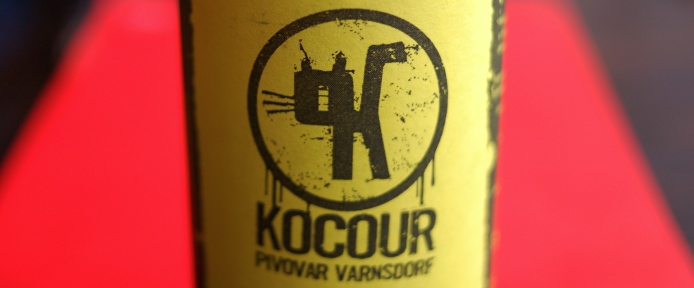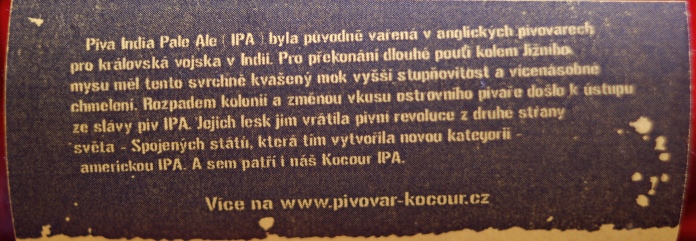Author’s note: the following “classic” Beer Culture post is from Friday, October 3, 2008. Along with many other posts, it disappeared in the Wormhole Incident™ and is therefore being re-posted here with a new permanent URL. If you have already read this post, please behave as if you were seeing it now for the first time.
We have always been at war with Eurasia.

On Monday, Pivovarský dům in Prague hosted a tasting of six beers from Pivovar Kocour, the Czech Republic’s newest brewery, with draft versions of Kocour’s 12° pale lager, English pale ale, Scottish ale, American IPA, V3 Rauchbier, and Stout. Like most of the attendees that night, I was impressed enough by these beers to consider the event a success.
However, since then I’ve had some time to think about Kocour’s success a little more. What strikes me now is much more than Kocour’s beer: in fact, in terms of planning, marketing and promotion, Kocour seems to be doing everything right. This comes in stark contrast to many small Czech brewers, who often seem to be doing just about everything wrong.
Some thoughts on what Kocour is getting right:
• Get Your Beer into Bottles. Yes, draft is far more popular in Central Europe, but the taps at most pubs — especially in Prague — are largely locked up by industrial brewers. If you want to have a chance of expanding beyond brewpub range, you have to get your beer into bottles ASAP. Even PET plastic bottles are fine, or standard recyclables — Kocour is using both — just so long as you have some means of getting your beer to the people who want it.
Remember that the bottles are a way of expanding your marketing, which brings us to the following:
• Think About Your Image. See that stylized cat logo in the label above? Kocour is one of the few Czech breweries I can think of — feel free to chime in, beer geeks — with a true logo ♣. This one works pretty well: it represents a tomcat, the meaning of the name “kocour” in Czech; the form of the letter K reinforces the Kocour name; the stencil-art, gritty, street style of the design promotes the idea that Kocour is new, cutting-edge, and somewhat of a punk, at least in Czech beer terms. (Brewing English and Belgian beer styles with imported ingredients is a lot like saying “bite me” to the mainstream Czech beer establishment.)
Compare that to a brewery like Strakonice, which at one point had at least four different brand names for its beers, and no uniform logo or label design.
Not only does Kocour have an iconic logo and design, but at the tasting they also presented their new glassware, all of which bears the tomcat logo. Oh yeah, and some dude — as in a beer fan, not an employee — was walking around wearing a Kocour T-shirt, which actually looked great. (Don’t forget that T-shirts and glasses can provide a secondary revenue stream for breweries. Of course, this only works if you actually have something worth buying. Like a cool design or good logo. Get it?)
• Never Miss a Chance to Talk About Your Beer. I will never understand why Czech breweries continue to waste space on their beer labels: You’ve got a bottle of your beer in someone’s hands. You can reasonably assume that the person holding the bottle is at least slightly interested in beer. And instead of taking that opportunity to spread your message, you have what, blank space? An etching of farmers and fields? A picture of some dead duke or baroness?
Just in terms of information on labels:
1) Tell us more about what ingredients and how you used them. Where do you get your malt? Does your brewery have its own maltings? What hops do you use? What’s special about them? Do you use 100% Saaz? Do you buy from a particular hopyard? Do you use any new Czech hop varietals like Agnus, Harmonie and Rubin? If so, why?
2) Don’t bullshit us. I’m serious, if I read “střední hořkost” (”medium bitterness”) one more time, I’m going to clock someone (I’m talking to you, Pivovar Herold). Treat beer lovers like the sophisticated, intelligent consumers you know we are. Don’t say “střední hořkost”: instead, tell us exactly how many IBUs — international bitterness units — your beer actually has. Tell us how long your brewery has brewed this particular beer in this particular way. Tell us the exact original gravity and how long it lagers. Tell us what kind of equipment you use, especially if you still use traditional open fermenters.
Give us something we can hold onto, something about your beer that we can wrap our brains around and you’ll have dedicated customers for life. Treat us like idiots and we’ll repay the favor.
On Kocour’s label for their American IPA, they include contact info for the brewery (a surprisingly rare thing on Czech beer labels); a recommended serving temperature (practically unheard of) of 7° C; a better-than-basic list of ingredients including the type of hops (”American Centennial”); and a good Czech overview of what an IPA is and where the inspiration for their version comes from.

Compared to “střední hořkost” or a painting of a dead baroness, this is a freaking Russian novel.
• Claim Your Ground. Did anyone check the list of beers at the tasting? Most are ales, a rare but increasingly popular thing in this country, and only one beer from the lineup — the 12° pale lager — is in a style regularly brewed here. In other words, it’s not just that Kocour is brewing a greater variety than just about any other single brewery in the Czech Republic. In fact, you could argue that Kocour is brewing a greater variety of beers than all the other breweries in the country put together.
But don’t be mistaken: it might sound like I’m saying that breweries should strive for variety. That’s not it. What I’m saying is that by claiming the ground of variety — by presenting itself as the Czech brewery that makes top-fermented beers and special beers — Kocour has very neatly defined itself: Kocour is the brewery for Czech beer geeks. Kocour is the brewery for people here who like foreign beer styles. In other words, Kocour has claimed its turf.
Compare that to Pivovar Nymburk, which brews a line of several very similar, good-but-not-great pale lagers and one dark lager. I challenge anyone to complete the phrase
“Nymburk is the brewery for _____________________________ ”
with anything other than “people from Nymburk.” That’s not enough to build and maintain a beer brand.
Unfortunately, it’s not just Nymburk: perhaps two dozen Czech medium-size breweries — Nová Paka, Chodovar, Janáček, Rebel, Pelhřimov, Ježek, etc. — have no clear “home turf.” Most of these breweries have very little to argue for their beers beyond simple regional patriotism. Good luck with that.
• Get Your Web Site In Order. This is the one place where Kocour lags, at least at the time of this writing: like many Czech brewers, Kocour has no web presence. However, we were told at the tasting that Kocour’s homepage at www.pivovar-kocour.cz should be up sometime this month. Beyond just presenting the beers, the web site is supposed to allow customers to actually order beers — in lightweight PET plastic bottles — on-line. Customers in the Czech Republic can then pay for the beer and shipping charges directly from the postman. (In the Czech Republic, postal COD remains a popular and highly functional way of shopping.)
That’s almost too smart, especially considering the difficulties most small Czech breweries have with distribution, and if Kocour can really pull that off, I’m sorry to say I’ll be slightly surprised. But given everything Kocour has done right so far, another success should really come as no surprise at all.
♣ In the comments for this post on BrewDog’s Punk IPA, Max and I discuss this point further. I stand by what I said here. NB, I’m not talking about a logotype, the name of the beer or other text set in a particular typeface, but rather a logo — a symbol or sign — just as I wrote above.




pivero
Just to be a pain in the ass. Why does it have to be a logo? Why can’t it be a well designed logotype, as many brands, including beer, around the world have? After all, a good logotype could also become an easily recognisable icon for a company. There are tonnes of examples of that.
That be said, I agree with you that Czech brewers need to do some work on the brading side of their operations.
PS: I still think that the carving of Sv. Norbert is a pretty fine logo.
kevin
where can I try some of this fabled brew ?
Honza
First tap in Prague we have is in Tlusta Koala-Senovážná 8, 110 00 Praha 1 – Nové Město, tel>
222245401. They serve our stout now. Beers should rotate and change every two weeks
Evan Rail
A je to!
Velky Al
Happy days! This is almost too perfect, an almost British style pub, with Kocour beers! Shame I can’t pop along tonight. But as it is just around the corner from my flat I am sure there will be plenty of trips along the road.